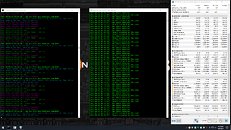Monday, September 4th 2017

RX Vega Achieves 43 MH/s @ 130 W in Ethereum Mining
AMD's RX Vega is more along the lines of an original computing card that was moved over to the consumer segment for gaming workloads than the other way around. Raja Koduri himself has said something along those lines (extrapolating a little more than what he can actually say), and that much can be gleaned with at least a modicum of confidence through AMD's market positioning and overall computing push. In the argument between gamers and miners, Raja Koduri didn't have all that much to say, but for AMD, a sale is a sale, and it would seem that after some tweaking, RX Vega graphics cards can achieve much increased levels of mining efficiency than their Polaris counterparts, further showing how Vega handles compute workloads much better - and more efficiently - than traditional gaming ones.Now granted, Vega's strength in mining tasks - Ethereum in particular - stems mainly from the card's usage of HBM2 memory, as well as a wide architecture with its 4096 stream processors. By setting the core clocks to 1000 MHz, the HBM2 memory clock at 1100 MHz, and power target at -24%, Reddit user S1L3N7_D3A7H was able to leverage Vega's strengths in Ethereum's PoW (Proof of Work) algorithm, achieving 43 MH/s with just 130 W of power (104 W of these for the core alone.) For comparison, tweaked RX 580 graphics cards usually deliver around 30 MH/s with 75 W core power, which amounts to around 115 W power draw per card. So Vega is achieving 43% more hash rate with a meager 13% increase in power consumption - a worthy trade-off if miners have ever seen one. This means that Vega 64 beats RX 580 cards in single node hashrate density, meaning that miners can pack more of these cards in a single system for a denser configuration with much increased performance over a similarly specced RX 580-based mining station. This was even achieved without AMD's special-purpose Beta mining driver, which has seen reports of graphical corruption and instability - the scenario could improve for miners even more with a stable release.Moreover, S1L3N7_D3A7H said he could probably achieve the same mining efficiency on a Vega 56, which isn't all that unbelievable - memory throughput is king in Ethereum mining, so HBm2 could still be leveraged in that graphics card. It seems that at least some of that initial Vega 64 stock went into some miner's hands, as expected. And with these news, I think we'd be forgiven for holding out to our hats in the expectation of increased Vega stock (at the original $499 for Vega 64 and $399 for Vega 56 MSRP) come October. Should the users' claims about RX Vega 56 efficiency be verified, and coeteris paribus in the mining algorithms landscape for the foreseeable future, then we can very much wait for respectable inventory until Navi enters the scene.
Source:
Reddit user @ S1L3N7_D3A7H






102 Comments on RX Vega Achieves 43 MH/s @ 130 W in Ethereum Mining
A good contrast: in earlier articles, you used the same sort of tone of voice but ended the article with a genuine question towards the opposite. Much better that way because it opens up the debate instead of steering it.
Yes, they have lowered ROI than some other cards - but if it's still profitable for them, they'll do it, especially with these undervolts and overclocks that bring Vega's compute power to the table. even more so now; and you also have to take into account pure performance density considerations, since a single Vega is (arguably) more interesting than a pair of RX 580's, simply because you can get a single vega for 2x RX 580's, thus achieving a smaller system footprint with the same - or almost equivalent - mining power.
That's why the argument works better for one side than the other, and that's why I insist it's a much better fit for miners than gamers.That's an excellent point, one that I can side with. While I don't feel it's clickbait, I admit that I force my own view on the matter somewhat forcefully, and immediately, with that title. And while my original interpretation of the title didn't see it that way, I understand perfectly why readers might.
As such, I will remove that excessive fat from the title, and leave this here for users to see how the change occurred.
while i am not disputing the facts in the piece, i just feel the title is a large part of the reason that people are already arguing in this thread. disputes which spill out across the whole forums and do not make it the friendly place it once was :(
I've made my arguments here in the comment section, and I still believe that currently Vega isn't a good option for gamers/enthusiast gamers. However, the way it was conveyed wasn't the correct one, and the one I want to have here on our site, so I prefer to take a step back instead of plowing through users' expectations.
In case of miners - it's all about the price. Even if Vega is the best possible mining card on the market, it still does not make sense to opt for a 7-8 months ROI, when less powerful options can give you profit in 4-5 months even with current inflated prices.
Vulkan is also going to merge with OpenCL for GPGPU applications. (sadly all nvidia GPUs support only OpenCL 1.2 while Intel and AMD already support 2.1 and 2.2 on the way).
Khronos stated during SIGGRAPH 2017 that Vulkan is going to be not just a graphics api, Vulkan is a GPU API .
Wccf ran their own tests that suggest that reddit users wrong as is the software he's using , hwinfo64.
I tried the latest hwinfo64 build and reported hbm memory watts drawn dropped from 100-165watts to never above 30 between builds.
And there in is the pertinent point , 90% of software does not work at all with vega regarding tuneing and monitoring software , so anyone saying anything finite about what vega can or can't do is probably missinformed including many reviewers and their overclocks , a power clamp is the only sure way I've seen of knowing vegas power draw .....
Thats a full stop comment , every software lies.
All of them are unreliable yet people are basing a lot of stuff and comments of of it, or less, word of mouth.
And YES, someone already tried to replicate and confirm the results. And came NOWHERE CLOSE!!!
wccftech.com/amd-rx-vega-64-pushed-43-5mhs-130w-mining-ethereum-eclipsing-polaris-efficiency-factor-2x/amp/
Proving it's total BS!!!
Let me quote myself for clarity on the matter:www.techpowerup.com/forums/threads/so-long-vega.236740/
I see that a friendly and reasoned reply from Vayra, I think, has disapeared, most likely because posted during the database transition. I never had a chance to read it properly unfortunately, but I would have been happy to reply to it.
The Vega reached the 980Ti (1070) and even the 1080. Why are you making fake conclusions?
I tossed it in my NCase build and the blower can barely keep up in the ITX case...FYI in case others were curious. Anyway, my rig idles around 60-70 watts. Using the same settings this person did, I'm pulling about 255 watts and the same 42-43 mh/s. Doing the math that puts the card around 180-190 watts. Definitely not 130 watts.
Attaching a super quick screenshot
Dear qubit, can you please kindly respond to the person with whatever information you have so as to clear up the misconceptions...?
Kthx. :)
Luckily I have lots of monopoly money.
This's UBIQ Coin , Not ETH Coin
UBIQ Coin use low power.
You didn't get my point though. ;)
":at today's fictional retail price. In terms of perf/W - a pair of undervolted GTX1060 6G's makes more sense and is abundant in stores worldwide."
Read the article, density is important to miners. In addition, GTX 1060 6GB cards are running about $300 right now.